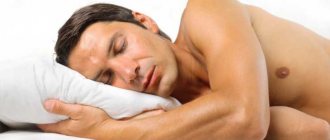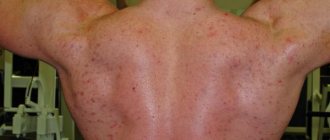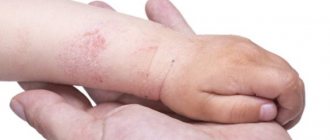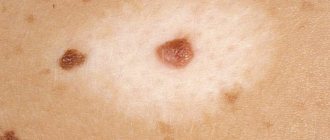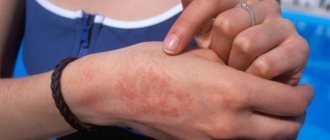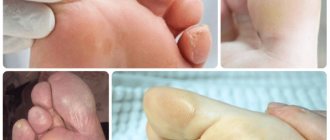It is very unpleasant when irritation appears on the face in the form of a small red rash or spots. Most often it is accompanied by itching, flaking and severe itching. It can appear at literally any age. It’s one thing when this happens to teenagers during puberty, and completely different when it happens at a more mature age, when you don’t know what to think.
Indeed, in the fight against this scourge, it is very important to understand what is happening, why the skin is covered with these hated pimples. If you eliminate the provoking factor, the irritation will disappear with it. Therefore, first we find out the reasons for this misfortune.
Causes
The skin is the largest organ on the human body, which performs protective and excretory functions. Women of all age groups with a history of chronic diseases are at risk. Most often, skin irritation occurs under the influence of the following factors:
- congenital features: increased sensitivity to environmental factors, sunlight, wind, etc.
- stress, constant psycho-emotional stress
- rosacea
- improper care with the use of inappropriate, aggressive cosmetics
- acne, eczema and other skin diseases
- alcohol abuse, smoking
- changes in weather conditions: temperature changes, cold air, active ultraviolet radiation, dust, unfavorable environmental conditions
- varicose veins
- allergic reactions
- traumatic injuries
- burns
- poor quality nutrition
- use of certain groups of drugs
- infectious agents: bacteria, viruses, parasites
- low-quality, irritating, inappropriate cosmetic procedures: peeling, facial cleansing, sauna, laser procedures
- genetic predisposition
- inflammatory processes in the body
The causes of facial skin irritation in women can also be associated with systemic diseases of the cardiovascular system, liver, pancreas, gastrointestinal tract, endocrinological disorders: diabetes mellitus, hypothyroidism.
Choose a specialist, read reviews and make an appointment with a dermatologist online
Poor nutrition
Skin irritation is often associated with poor diet. Certain foods act as triggers that cause redness, dryness, and dermatitis. Most often, such a reaction occurs against the background of an excess amount of simple carbohydrates, lectins, nightshades, and citrus fruits. Intolerance to dairy products and gluten is becoming more common.
Important! To select a suitable diet and restore the integrity of the walls of the gastrointestinal tract, it is recommended to contact a nutritionist, dietician, or preventive medicine specialist.
To cope with the problem, it is recommended to follow an antihistamine diet and eliminate the most common triggers of irritation and inflammation on the skin. It is necessary to keep a food diary: this makes it easier to track which food product provoked the reaction of irritation, redness, and worsening the condition of the skin. Any diet is prescribed for a certain period of time. They exclude all possible triggers for several months, after which they introduce products one at a time, observing the body’s reaction.
Rosacea
Rosacea is a chronic pathology in which redness of the skin is observed, pustular rashes occur, and the dermis thickens. It occurs in women with increased sensitivity of blood vessels on the face, as well as with a hereditary predisposition to this disorder. The situation is aggravated by negative factors:
- temperature changes
- exposure to dry or hot air
- vasodilatation
The risk group includes women with a history of gastritis and activation of Helicobacter pylori infection. The clinical picture is aggravated if the patient uses hormonal ointments from the group of corticosteroids for a long time. This leads to thinning of the arteries, increasing their sensitivity to temperature fluctuations and increased fragility.
Aggravation of rosacea is observed when interacting with cold or hot water, after drinking alcohol, hot tea or coffee. The skin becomes red and irritated. Typical localization: T-zone, cheeks, forehead. The texture of the skin becomes rougher, denser, persistent expansion of capillaries and blood flow leads to a local increase in temperature. Lack of therapy leads to the formation of tubercles and irregularities, which over time can transform into ulcers.
Avitaminosis
A deficiency of nutrients and essential substances can also cause irritation on the facial skin in women. To identify what substances the body lacks, it is recommended to undergo a general and biochemical blood test, and a urine test for organic acids. Means for correction are selected individually, taking into account the results of a comprehensive examination. In case of severe deficiencies, diet correction is not enough and patients are prescribed medications, dietary supplements, and in severe cases, IV drips.
Twice a year it is recommended to take a course of high-quality multivitamin complexes with active substances in chelated forms. For people on a plant-based diet, it is important to monitor the levels of iron, ferritin, and zinc. To normalize the absorption of nutrients from food, it is necessary to restore the flow of bile and use enzyme and choleretic medications selected by a doctor.
Cuperosis
Cuperosis is a disease that occurs in patients with microcirculation disorders. Leads to excessive expansion of capillaries with subsequent violation of their integrity. The skin of the face becomes irritated, pale red or bluish-red areas with dilated vessels and “stars”—the vascular network—are formed.
Important! Couperosis most often affects the forehead, cheeks, chin, nose, and less often spreads to the lower extremities.
The disorder occurs under the influence of the following predisposing factors:
- prolonged exposure to direct sunlight
- stress
- excessive physical activity
- excessive consumption of alcoholic beverages, which lead to persistent dilation of blood vessels
- smoking, which causes blood vessels to narrow
- temperature changes combined with strong winds
- eating excessively spicy, hot foods, which leads to increased blood circulation
- abuse of coffee, chocolate, cocoa
In turn, rosacea with irritation of the skin on the face can be a manifestation of other pathological conditions: scleroderma, systemic lupus erythematosus, congenital immunodeficiency conditions.
Dermatitis
Dermatitis is a large group of skin pathologies that occurs with prolonged exposure to external aggressive factors and a decrease in the body’s defenses. Chemical, biological, and mechanical irritants lead to inflammatory reactions of the skin, which are externally similar to allergies. The clinical picture manifests itself depending on the causative agent of the pathological process. The degree of irritation of the skin on the face depends on the duration of exposure to the irritant and the individual characteristics of the body. This can range from mild redness to deep ulcerative lesions.
Women who have been using hormonal medications for acne and rosacea for a long time are at risk. Dermatitis also occurs in patients with a history of chronic gastrointestinal disorders or food intolerances. The skin takes on a red tint, and there may be a slight local increase in body temperature.
Improper care
Often, problems with skin condition can be caused by improper care. For example, overly aggressive, deep cleansing washes away the protective film, leading to dryness and trauma to the skin. As a result, the skin turns red, becomes irritated, and becomes dry and itchy.
Cosmetologists urge women to refrain from aggressive cleansing of the skin “to the point of squeaking.” As the protective barrier breaks down, rashes and irritation occur. Oily, problematic skin also requires soft and delicate cleansing using cream gels, foams, and mousses. You can learn more about choosing the right care from a cosmetologist.
Scarlet fever
Scarlet fever is an acute infection that affects the oropharynx. Accompanied by severe intoxication and skin irritation. The causative agent is streptococcal infection. Scarlet fever carriers are most dangerous during the first few days from the onset of the disease. Infection occurs by airborne droplets. The average incubation period is 1 week.
There is an acute onset of scarlet fever, the body temperature rises sharply, and accompanying characteristic signs are observed in the form of:
- headache
- muscle aches
- general weakness
- tachycardia
- significant deterioration in general health
- apathy
- drowsiness
- vomiting
The skin of the face becomes irritated, acquires a red tint, and a rash forms within 2-3 days. The punctate elements of the rash begin to merge over time, which leads to the formation of extensive erythema. The most irritated skin is the forehead, cheeks, and temples.
Chickenpox
Chickenpox is an acute infectious disease of viral origin. Leads to irritation of the skin of the face and body. The causative agent of the pathological process is herpesvirus, transmitted by airborne droplets. The disease is accompanied by redness, itching, and the formation of papules with watery contents.
The duration of the incubation period is up to 20 days. In adults, chickenpox is more severe. In addition to irritation of the skin of the face and body, there is a significant increase in body temperature, complaints of headache, aching joints, deterioration in general health, and nausea. The skin rash is accompanied by itching, and pustules form when scratched.
Eczema
Eczema is an inflammatory process that affects the skin, which has a long, chronic course and is accompanied by constant exacerbations. Nodules and blisters form on the surface of the skin, followed by weeping crusts, erosions and peeling. External manifestations lead to skin itching and burning. Lack of therapy increases the risk of secondary infections. Severe eczema provokes neurosis: insomnia, irritability, persistent cosmetic defects of the skin.
Predisposing factors that can lead to eczema include hereditary predisposition, adverse effects of environmental factors, poor diet, and a history of allergic diseases. Depending on the form of the disease, antihistamines, sedatives, corticosteroids, and elements of physiotherapy are used during therapy.
Stress
Stressful situations often lead to chronic fatigue and lack of sleep, and stimulate the production of the stress hormone cortisol. When this hormone is elevated over a long period of time, the following disorders occur:
- digestive dysfunction
- cardiovascular diseases
- immunity decreases
Increased cortisol affects the condition of the skin: the regeneration process slows down and the amount of fat produced decreases. Coping with stress requires a comprehensive approach.
Important! Women are advised to spend more time on themselves, attend relaxing spa treatments, and improve their sleep patterns.
At home, you can take a bath with aromatic foam, essential oils, and soy aroma candles. Yoga classes, breathing exercises, and attending educational trainings on topics of interest are useful. It is important to follow a work-rest schedule and go to bed on time: no later than 23:00 in a completely dark, cool room.
Exposure to hot water
Often the skin on the face can become temporarily irritated due to prolonged exposure to hot water. The situation gets worse when large amounts of bleach are used for cleaning. Hot water dissolves fat, including the protective lipid layer on the skin of the face. In combination with soap and other aggressive detergent components, this leads to dehydration, itching, flaking, and tightness.
Cosmetologists recommend using cool water and mild detergents for washing: cream gels, foam. You need to allow the skin to dry on its own, apply a small amount of tonic and moisturizer selected according to your skin type. This allows you to retain moisture in the epidermis and prevent skin irritation.
Unfavorable environmental conditions
Skin irritation is often observed when exposed to adverse environmental conditions. Constant exposure to dust, gases, aerosols, air conditioners, and tobacco smoke lead to the synthesis of free radicals, which negatively affect the condition of the skin. The skin becomes dry, inflamed, and dehydrated.
Important! In this case, products containing lysates, bifidobacteria, and peptides will be useful. Similar serums and essences are presented in the lines of Korean cosmetics.
To reduce the negative impact, it is necessary to use soft, hypoallergenic products for cleansing and facial care. Caring medications restore the lipid barrier and reduce susceptibility to adverse environmental conditions.
How to treat irritation and acne from sweat
With excessive sweating (hyperhidrosis), various pathological processes occur in the skin. The following types of skin changes are distinguished: specific dermatitis or miliaria, cholinergic urticaria, acne.
Miliaria occurs primarily in infants, but can also occur in adults. Appears on the skin of the face, body and in skin folds (in the armpit and groin areas, under the mammary glands in women and obese men), between the thighs with excess weight.
Which doctor should I contact?
In case of irritation or redness of the facial skin, it is recommended to consult a dermatologist. The doctor will conduct an in-person examination and prescribe a comprehensive examination. It is important not just to remove the symptom, but to influence the root cause of the irritation. In the future, consultation with doctors of related specialties may be required:
- gynecologist
- endocrinologist
- hepatologist
- infectious disease specialist
- gastroenterologist
- allergist
Experts recommend refraining from self-medication so as not to aggravate the course of the disease and not provoke complications.
Choose a specialist, read reviews and make an appointment with a dermatologist online
Rash due to sweat
Content:
Sweat rash is not a rare occurrence. This condition is popularly called prickly heat. It is characterized by the appearance of rashes, itching, and irritation. Sometimes people even notice a burning sensation. This condition brings complete discomfort and can contribute to the addition of a bacterial infection. Let's look at the symptoms and all the ways to combat it.
Diagnostics
To confirm the diagnosis, the doctor conducts a face-to-face examination and interview of the patient. Asks questions regarding lifestyle, diet, drinking regime, physical activity, stress. The following studies are carried out:
- skin tests: scrapings are made from the surface of the skin for further microscopy
- general blood test to identify the inflammatory process
- biochemical blood test: ALT/AST, lipid profile, glucose, insulin, glycosylated hemoglobin, TSH, T3, T4
- conducting allergy tests
If an infection is detected, a serological test is performed using the PCR technique. Elements of instrumental diagnostics are indicated if systemic pathologies are suspected. The doctor may suggest an ultrasound of the thyroid gland, pelvic organs and abdominal cavity.
Buy cosmetics with a mineral base
Facial care products with benzoyl peroxide or sodium lauryl sulfate, alcohol cause hyperemia, itching, peeling and swelling of the skin. To avoid these unpleasant symptoms, buy mineral-based facial cosmetics. They contain zinc oxide or titanium dioxide, which prevent irritation, acne and redness. Mineral makeup absorbs excess sebum that clogs pores.
- Zucchini pancakes in the oven - step-by-step preparation. Recipes for zucchini pancakes with photos
- Turnip salad - recipes with photos. How to make a simple and delicious turnip or turnip salad
- Intercostal neuralgia - symptoms on the left and right
Treatment
More than 15% of women around the world face the problem of chronic skin irritation. Often the problem is caused by the influence of several factors at once, which complicates therapy. To achieve the best result, an integrated approach and compliance with all recommendations of the attending physician are required. Treatment of skin irritation in women begins with eliminating the root cause that caused such a symptom.
Treatment of irritation and cracks comes down to gentle cleansing, softening, treatment and protection. For this purpose, they use bactericidal agents, emollient creams and emulsions, and protective balms. To reduce irritation, pain and discomfort, follow these recommendations:
- When cleaning, do not use products that contain alcohol.
- use thermal water to soften the skin and restore natural microflora
- several times a day use protective and regenerating skin products that accelerate skin recovery and are designed specifically for dry, irritated skin
- after the skin has recovered, select a suitable sunscreen
- use only high-quality cosmetics, carefully study the composition
To locally reduce irritation, preparations based on emu oil, tamanu, and dexpanthenol are used. Decoctions of medicinal plants that are used to prepare lotions are useful. In the future, you should refrain from using alcohol-based products. When selecting cosmetics, it is recommended to give preference to hypoallergenic products without silicones or fragrances.
Factors that can trigger an allergic reaction to sweat
In addition to chronic diseases, there are factors that increase the likelihood of developing allergies. Under their constant influence, urticaria may not go away for a long time, since the secretion is released again and again, while the allergic reaction to acetylcholine persists.
These factors include:
- High body temperature;
- Stressful state;
- Physical exercise;
- High temperature and humidity of the environment (for example, a bathhouse);
- Drinking plenty of fluids;
- Hot food and drinks, as well as smoked, fatty and spicy dishes.
Relapses are also possible, when, with ineffective treatment of the causes of urticaria, the disease returns again and again, worsening with each new relapse.
Prevention
To prevent skin irritation, adhere to the following recommendations:
- Maintain personal hygiene: wash with warm water, be sure to remove makeup before going to bed
- choose suitable products for home care, make sure that it does not dry out
- Avoid exposure to direct sunlight and strong winds
- use quality sunscreens
- refrain from popping pimples
- choose suitable skincare products: cleanser, toner, serum, cream
- diversify your diet with fiber, seasonal vegetables, fruits, berries, easily digestible protein, choline, eggs, seeds, nuts, high-quality vegetable oils as polyunsaturated fatty acids
- promptly treat emerging disorders: skin diseases, systemic disorders
- If possible, refrain from taking medications that cause skin irritation
At the first symptoms of a disorder, it is recommended to immediately seek medical help. The earlier treatment begins, the better the prognosis. If the recommended therapy is ineffective, you should consult your doctor again and reconsider the treatment regimen.
Reviews
Ksenia. Every time after using soap, including liquid soap, to depilate my legs, I received terrible irritation. I chose shaving gel with menthol, and after the procedure I rinse my legs with mint infusion or apply talcum powder. No inflammation. It is also important not to forget about the sharpness of the blades and the quality of the machine.
Marusya. I like Boro Plus cream. If pimples or redness appear after shaving, I rub it into the skin and everything goes away quickly. Another option is baby oil with aloe added. It is better to apply it to wet feet and then blot with a towel.
Natalie. Products with panthenol save me from irritation after shaving my legs. In the cold season I use Bepanten cream, and in the warm season I use Panthenol anti-sunburn foam. After them, the skin quickly calms down, and small wounds heal.
Irritation of the skin of the legs after using the razor in most cases occurs when shaving rules are violated. This is why it is important to keep the blades sharp and clean, and to soften and moisturize the skin during and after the procedure. Also, the main cause of irritation is ingrown hairs. If redness occurs, products with aloe, panthenol and antiseptic herbs are the most effective to get rid of them. Ointments with a pronounced therapeutic effect should be applied only to very severe injuries and not too often.
